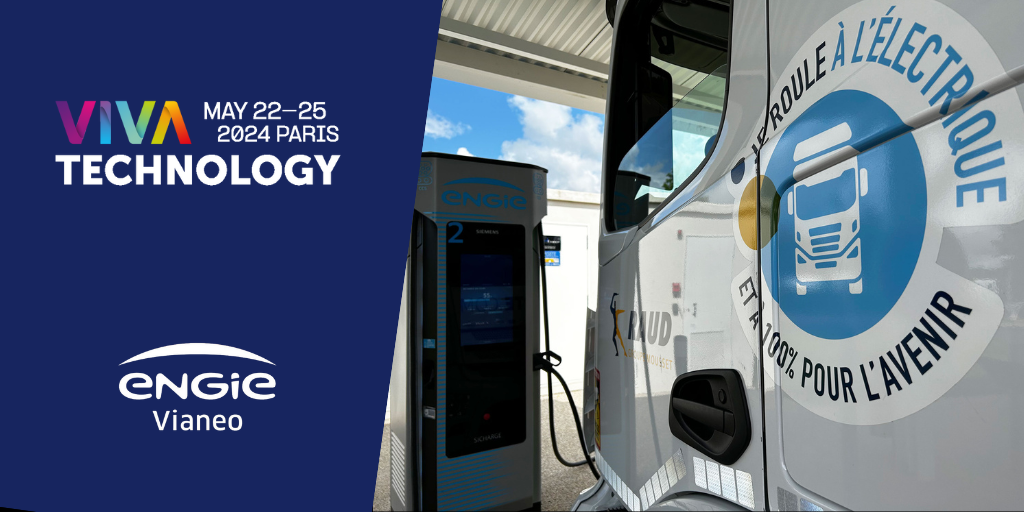


Electric heavy-duty trucks are a simple, reliable, green and economical alternative to conventional diesel trucks, and it's worth taking the plunge.
The ENGIE Group is a leader in energy transition, so it's only natural that ENGIE Vianeo, the Group's brand dedicated to electric mobility, should aim to decarbonise road transport. Vianeo is developing a high-power, high-quality network that aims to enable users of all types of electric vehicle to recharge as easily and as seamlessly as possible, from the development of an application to find the charging points to their use, whilst remaining transparent in terms of price. However, our contribution does not end with the establishment of these charging stations: we are involved in everything from market research to energy supply, including estimating traffic flows, designing the stations and ensuring they are well distributed throughout the country. We also help new EV drivers get to grips with their vehicle. This is really the heart of our business: offering simple, transparent and committed access to electromobility - not least because all the electricity in our network of charging points is green.
The charging points are different, but there are issues common to both, such as the véhicle-to-grid (V2G) technology, which allows vehicles to alternately receive energy from the electricity grid to charge and then supply it in turn, thanks to their batteries, during the night, for example. But today, our major issue is the energy transition of heavy goods vehicles, which are closely linked to industrial logistics. Although heavy goods vehicles in France account for only 1.3% of all vehicles, they are responsible for 27% of CO2 emissions linked to transport.This is because a lorry is always on the move, unlike a private car, which is often stationary. Heavy duty trucks are a major lever for decarbonising mobility. That's why we want to offer dealers and hauliers turnkey solutions to speed up the transition of their fleets. At Viva Technology, we will be speaking to them in particular.
We will provide a broad overview of the short and longer-term outlook. We are currently working with APRR (Autoroutes Paris-Rhin-Rhône) to develop a very high-power electric recharging network designed exclusively for heavy goods vehicles. This is a first in France. Five stations equipped with a 400-500 kW charging point, two ultra-fast charging points and a back-up charging point, will be installed between Paris and Lyon. This section should be brought into service before the summer.
There are also elements that are currently experienced as constraints by carriers, we would like to transform this. For a haulier, loading time can quickly lead to a loss of efficiency and therefore of profitability. It's true that filling up with petrol takes less time than recharging your electric vehicle, but this time also allows you to take a real break... that's why we're working with hauliers to create a network across the country so that the charging time coincides with their drivers' statutory break of 45 minutes every 4.5 hours, for example.
To avoid bottlenecks and wasted time, we are also looking at solutions that will allow carriers to book their slots in advance. It's all these elements that we'll be showing at Viva Tech to promote the electric vehicle solution. There are no problems, only solutions!
As a pioneer in innovation and energy transition, ENGIE has a duty to be present at Vivatech. For electric mobility in particular, it's important to educate people, because while light vehicles are now in the mass market phase, the market for electric heavy goods vehicles is still in its infancy. So it's very important to reassure people that these vehicles are a simple, reliable, green and economical alternative to conventional diesel trucks, and that it's worth taking the plunge. Electricity is no more complicated than petrol, once you understand how charging works, the types of plugs and the electricity prices that vary according to the time of day - just as we had to get used to the subtleties of petrol and diesel, which we've forgotten. In fact, our role is to implement solutions that remove psychological blockages. At first, the blockage was on the terminal in the depot where you park your truck. So we've sorted that out. The new bottleneck is charging outside the depot, on the motorway, on major roads, in logistics zones and at the entrance to major low-emission zones (ZFE). Today, that's where we're focusing our efforts to meet the need for remote recharging far from home.
The invention of the wheel is often referred to as an essential innovation. But one author, Eric-Emmanuel Schmitt, has suggested that the road is an even more crucial innovation, and I find his vision very interesting. Because a wheel on stony ground is useless. The road seems obvious, as if it had always been there. And yet it was a major structural innovation that led to the emergence of the wheel, and also the railways. So I'd say hit the road!
We're making good progress. And I would even go so far as to say that our ambitions are also very concrete outside France. We already have a significant business in Belgium, and it's expanding in Germany, Italy and Spain, for both HGVs and cars, depending on requirements. And beyond Europe, the ENGIE Group also operates electric mobility in Australia, Singapore and the United States. We are convinced that it is by paying close attention to the first trials that we will be able to provide the most favourable feedback on the market, and thus speed up the decision-making process for all transport operators. Successful first experiences mean several years' head start in decarbonising transport.